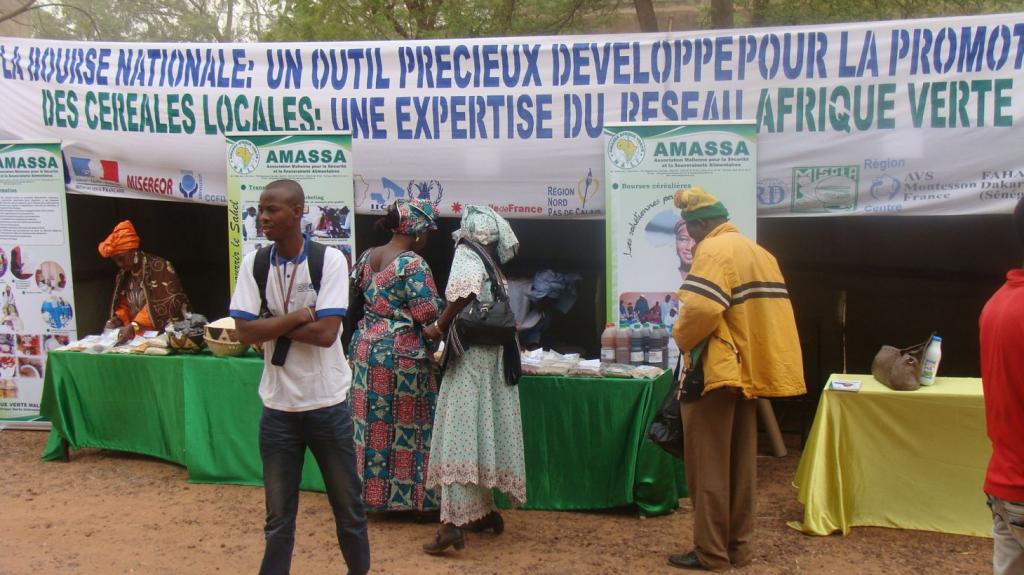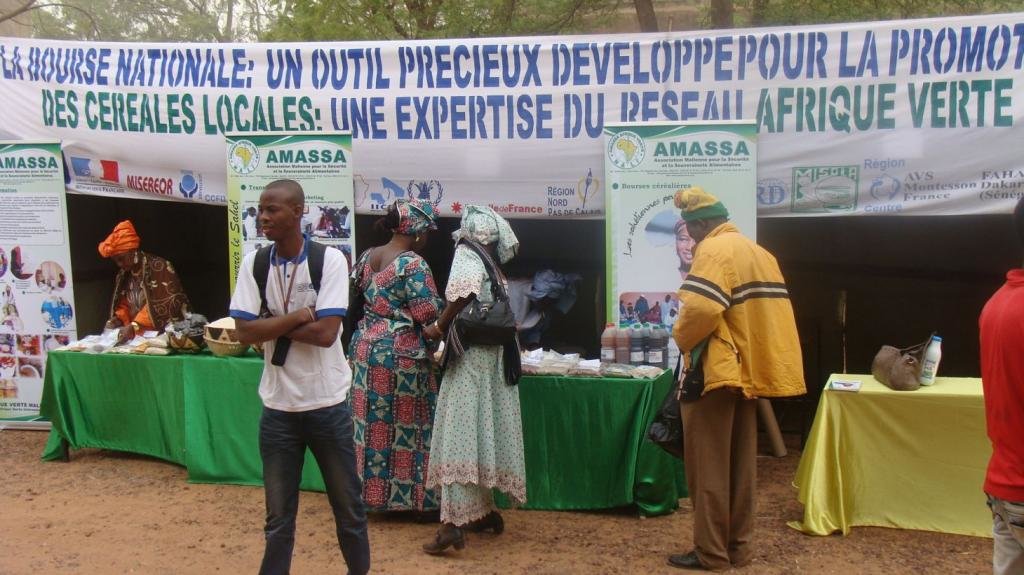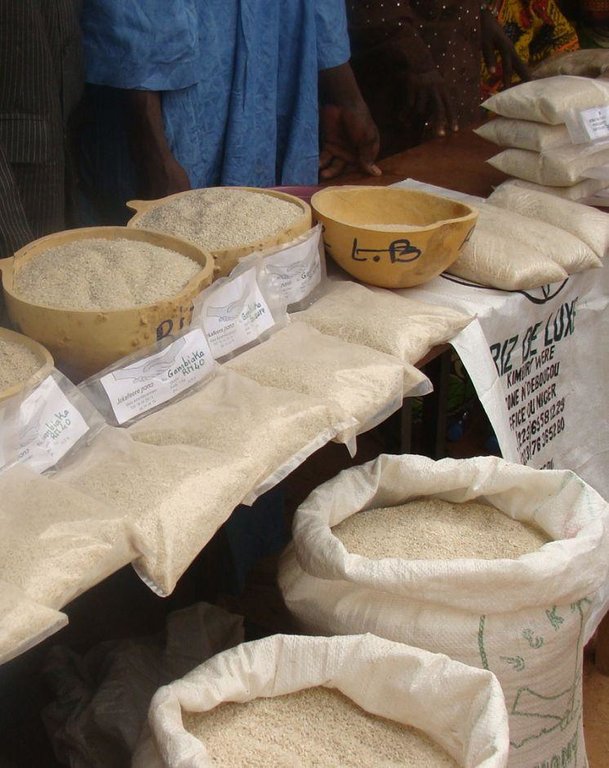Grain exchanges [ប្រទេសម៉ាលី]
- ការបង្កើត៖
- បច្ចុប្បន្នភាព
- អ្នកចងក្រង៖ Dieter Nill
- អ្នកកែសម្រួល៖ –
- អ្នកត្រួតពិនិត្យ Laura Ebneter
Bourses aux céréales (French)
approaches_2511 - ប្រទេសម៉ាលី
ពិនិត្យមើលគ្រប់ផ្នែក
ពង្រីកមើលទាំងអស់ បង្រួមទាំងអស់1. ព័ត៌មានទូទៅ
1.2 ព័ត៌មានលម្អិតពីបុគ្គលសំខាន់ៗ និងស្ថាប័នដែលចូលរួមក្នុងការវាយតម្លៃ និងចងក្រងឯកសារនៃវិធីសាស្ត្រផ្សព្វផ្សាយ
អ្នកជំនាញឯកទេស SLM:
Haidara Mohamed
afriqueverte@afribone.net.ml
AMASSA - Afrique Verte Mali
ប្រទេសម៉ាលី
អ្នកជំនាញឯកទេស SLM:
Ballo Yacouba
capi@afribone.net.ml
AMASSA - Afrique Verte Mali
ប្រទេសម៉ាលី
ឈ្មោះអង្គភាពមួយ (ច្រើន) ដែលបានចងក្រងឯកសារ/ វាយតម្លៃលើវិធីសាស្ត្រផ្សព្វផ្សាយ (បើទាក់ទង)
Deutsche Gesellschaft für Internationale Zusammenarbeit (GIZ) GmbH (GIZ) - ប្រទេសអាល្លឺម៉ង់ឈ្មោះអង្គភាពមួយ (ច្រើន) ដែលបានចងក្រងឯកសារ/ វាយតម្លៃលើវិធីសាស្ត្រផ្សព្វផ្សាយ (បើទាក់ទង)
L'Association Malienne pour la Sécurité et la Souveraineté Alimentaires - Afrique Verte Mali (AMASSA - Afrique Verte Mali) - ប្រទេសម៉ាលី1.3 លក្ខខណ្ឌទាក់ទងទៅនឹងការប្រើប្រាស់ទិន្នន័យដែលបានចងក្រងតាមរយៈវ៉ូខេត
តើពេលណាដែលទិន្នន័យបានចងក្រង (នៅទីវាល)?
01/07/2012
អ្នកចងក្រង និង(បុគ្គលសំខាន់ៗ)យល់ព្រមទទួលយកនូវលក្ខខណ្ឌនានាទាក់ទងទៅនឹងការប្រើប្រាស់ទិន្នន័យដែលបានចងក្រងតាមរយៈ វ៉ូខេត:
បាទ/ចា៎
2. ការពណ៌នាអំពីវិធីសាស្ត្រផ្សព្វផ្សាយ SLM
2.1 ពណ៌នាសង្ខេបខ្លីពីវិធីសាស្ត្រផ្សព្វផ្សាយ
Link up production areas with the areas where grain is consumed in order to encourage the flow of cereals from one area to the other
2.2 ពណ៌នាលម្អិតពិវិធីសាស្ត្រផ្សព្វផ្សាយ
ពណ៌នាលម្អិតពិវិធីសាស្ត្រផ្សព្វផ្សាយ:
The objective of grain exchanges is to link up production areas with the areas where grain is consumed in order to encourage the flow of cereals from one area to the other. In this way, the
exchanges contribute to stabilising market prices and informing cereal producers about how these markets function.
The support structure (AMASSA – Afrique Verte Mali, a body devolved from the French NGO
Afrique Verte) invites producers and buyers to participate in a two to three-day grain exchange. This process of connecting up parties allows producers to assess grain production levels for the current season and buyers to get an idea of the grain stocks available. The two parties then negotiate grain quantities and prices. A good number of contracts are agreed during the exchange, and the agreement of further contracts after the exchange is likely. The exchange also serves to foster exchange among other actors involved in the sale and production of grain.
Organising exchanges involves several stages: First, supplies are identified in areas with high levels of dry cereal production (millet, sorghum and maize in the Sikasso, Koutiala, Ségou, Senon de Koro/Bankass plains) and rice production (in the Niono rice growing region in the Office du Niger). At the same time, the needs of consumption areas (supply cooperatives in Kayes Region and grain banks in the areas of Gao, Timbuktu and Kidal) and major consumption centres with processing plants, merchants and consumer cooperatives (such as Bamako) are identified. The supply cooperatives from rice-deficit areas (the Kayes area, for example) are identified and their needs recorded (bulk purchasing requests). Producers’ associations in the Niono region in the Office du Niger area are identified and their rice surpluses ascertained. Supplies for sale are then quantified and stockholders are encouraged to put together a bulk sales offer. Finally, a meet-and-greet workshop is held to foster exchange and discussion on grain supply and demand.
Role of stakeholders: AMASSA – Afrique Verte Mali catalogues and groups offers (purchase or sale) and cereal requirements during the pre-exchanges, and promotes the exchange among relevant cereal operators (advertising). AMASSA also provides financial and technical support in organising the exchange (venue hire, refreshments). Supply cooperatives and private operators support the process of identifying cereal requirements prior to the exchange and then participate in the exchange itself. Their role is to buy stock. Producers’ associations communicate how much of their stock is available and trade this in bulk at the exchange. The legal advisor helps draw up the sales contracts and explains the content of sales contracts to operators. Others, such as technical partners in the sector (Planning and Statistical Unit of the Ministry of Agriculture, DNSI, OMA, OPAM, Customs Service, EWS, WFP, National Agency for Food Safety and Security, etc.), provide additional specific information.
The transactions carried out in the exchanges are fairly advantageous both for the sellers (producers and their organisations) and the buyers (merchants, supply cooperatives, consumer cooperatives, processing outfits). These advantages can be measured in terms of price and quality. The grain exchanges are prized by many actors and an increasingly large number of structures have built them into their support mechanisms. The farming profession is interested in this approach. For this reason, the exchanges are increasingly being jointly delivered by APCAM and often by the Association of Professional Farming Organisations (AOPP) and projects and/or NGOs. The fact that the farming profession is appropriating the exchange concept bodes well for its sustainability.
2.3 រូបភាពនៃវិធីសាស្ត្រផ្សព្វផ្សាយ
2.5 ប្រទេស/តំបន់/ទីតាំងកន្លែង ដែលវិធីសាស្ត្រផ្សព្វផ្សាយត្រូវបានអនុវត្តន៍
ប្រទេស:
ប្រទេសម៉ាលី
តំបន់/រដ្ឋ/ខេត្ត:
Mali
បញ្ជាក់បន្ថែមពីលក្ខណៈនៃទីតាំង:
Niono, Koutiala, Sévaré-Mopti, Ségou, Kayes
2.6 កាលបរិច្ឆេទនៃការចាប់ផ្តើម និងបញ្ចប់នៃវិធីសាស្រ្តផ្សព្វផ្សាយនេះ
សូមបញ្ជាក់ឆ្នាំដែលបានបង្កើតឡើង:
1995
2.7 ប្រភេទនៃវិធីសាស្ត្រផ្សព្វផ្សាយ
- ផ្អែកលើគម្រោង/កម្មវិធី
2.8 គោលបំណង/ទិសដៅសំខាន់នៃវិធីសាស្ត្រផ្សព្វផ្សាយ
The objective of grain exchanges is to link up production areas with the areas where grain is consumed in order to encourage the flow of cereals from one area to the other. In this way, the exchanges contribute to stabilising market prices and informing cereal producers about how these markets function.
The SLM Approach addressed the following problems: weak link of production areas with the areas where grain is consumed, unstable market prices
2.9 លក្ខខណ្ឌអនុញ្ញាត ឬរារាំងការអនុវត្តន៍បច្ចេកទេសដែលស្ថិតនៅក្រោមវិធីសាស្រ្តផ្សព្វផ្សាយ
ផ្សេងៗ
- រារាំង
weak link of production areas with the areas where grain is consumed
Treatment through the SLM Approach: The support structure AMASSA – Afrique Verte Mali invites producers and buyers to participate in a two to three-day grain exchange. This process of connecting up parties allows producers to assess grain production levels for the current season and buyers to get an idea of the grain stocks available. The two parties then negotiate grain quantities and prices. A good number of contracts are agreed during the exchange, and the agreement of further contracts after the exchange is likely.
3. ការចូលរួម និងតួនាទីរបស់ភាគីពាក់ព័ន្ធ
3.1 អ្នកពាក់ព័ន្ធដែលបានចូលរួមក្នុងវិធីសាស្ត្រផ្សព្វផ្សាយ និងតួនាទីរបស់ពួកគេ
- អ្នកប្រើប្រាស់ដីក្នុងតំបន់/សហគមន៍
- អ្នកឯកទេសគ្រប់គ្រងដីប្រកបដោយចីរភាព/ទីប្រឹក្សាបច្ចេកទេសកសិកម្ម
- អង្គការក្រៅរដ្ឋាភិបាល
- រដ្ឋាភិបាលថ្នាក់មូលដ្ឋាន
- រដ្ឋាភិបាលថ្នាក់ជាតិ (អ្នករៀបចំផែនការ អ្នកសម្រេចចិត្ត)
3.2 ការចូលរួមរបស់អ្នកប្រើប្រាស់ដីក្នុងតំបន់/ សហគមន៍ក្នុងតំបន់ក្នុងដំណាក់កាលផ្សេងគ្នានៃវិធីសាស្រ្តផ្សព្វផ្សាយ
| ការចូលរួមរបស់អ្នកប្រើប្រាស់ដីក្នុងតំបន់/សហគមន៍ក្នុងតំបន់ | សូមបញ្ជាក់នរណាត្រូវបានចូលរួម ព្រមទាំងពណ៌នាសកម្មភាពទាំងនោះ | |
|---|---|---|
| ការចាប់ផ្តើម/ការលើកទឹកចិត្ត | អសកម្ម | |
| ការរៀបចំផែនការ | អន្តរកម្ម | |
| ការអនុវត្តន៍ | អន្តរកម្ម | |
| ការត្រួតពិនិត្យ និងវាយតម្លៃ | អន្តរកម្ម | |
| Research | អសកម្ម |
3.4 ការសម្រេចចិត្តលើការជ្រើសរើសបច្ចេកទេស SLM
សូមបញ្ជាក់តើអ្នកណាជាអ្នកបានសម្រេចចិត្តក្នុងការជ្រើសរើសបច្ចេកទេសដើម្បីយកមកអនុវត្តន៍:
- អ្នកប្រើប្រាស់ដី ដោយមានការគាំទ្រពីអ្នកជំនាញឯកទេស SLM
ចូរពន្យល់:
Decisions on the method of implementing the SLM Technology were made by mainly by SLM specialists with consultation of land users
4. ជំនួយបច្ចេកទេស ការកសាងសមត្ថភាព និងការគ្រប់គ្រងចំណេះដឹង
4.1 ការកសាងសមត្ថភាព/ បណ្តុះបណ្តាល
តើវគ្គបណ្តុះបណ្តាលបានផ្តល់ឱ្យអ្នកប្រើប្រាស់ដី/អ្នកពាក់ព័ន្ធផ្សេងៗទៀតដែរឬទេ?
បាទ/ចា៎
សូមបញ្ជាក់តើអ្នកណាត្រូវបានបណ្តុះបណ្តាល:
- អ្នកប្រើប្រាស់ដី
ទម្រង់នៃការបណ្តុះបណ្តាល:
- អនុវត្តន៍ជាមួយការងារ
- ពីកសិករទីកសិករ
- ការប្រជុំជាសាធារណៈ
ប្រធានបទបណ្តុះបណ្តាល:
Before each workshop, facilitators from AMASSA – Afrique Verte Mali ascertain the grain needs of consumer regions in order to bulk together orders to the different supply cooperatives and grain banks. Likewise, producers’ available grain stocks are ascertained and bulked to build a substantial supply. To ascertain the needs of the parties involved, AMASSA – Afrique Verte Mali organises forums in the main production areas called ‘pre-exchanges’. These pre-exchanges are, in effect, regional preparatory meetings where around 80 to 100 people come together to assess the offers available and the approaches for bulking supply and demand.
In addition, facilitators use the pre-exchanges to train organisations in market negotiation techniques, price setting and drawing up sales contracts. An area of particular focus is the content of contracts (delivery deadlines, quality and standards to be delivered, quantities, packaging requirements, etc.) and the consequences of failing to meet the terms of the contract. A series of pre-exchanges are rolled out in different locations.
In practice, the exchanges serve as platforms for information exchange that give operators the opportunity to get up to speed with certain key aspects of the trade. They provide information on the status of cereal production, areas facing food scarcity or economic difficulties, cereal price trends, legislative and regulatory procedures relating to cross-border trade, invitation to tender opportunities for replenishing the National Security Stock (SNS) and sales of intervention stocks. This range of information is essential and enables operators to better position themselves in the grain market.
4.2 សេវាផ្តល់ប្រឹក្សាយោបល់
តើអ្នកប្រើប្រាស់ដីបានទទួលនូវសេវាផ្តល់ប្រឹក្សាដែរ ឬទេ?
បាទ/ចា៎
ពណ៌នា/ពន្យល់:
Advisory service is quite adequate to ensure the continuation of land conservation activities
4.3 ការពង្រឹងសមត្ថភាពស្ថាប័ន (ការអភិរឌ្ឍន៍អង្គភាព)
តើស្ថាប័នទាំងអស់ត្រូវបានបង្កើតឡើង ឬពង្រឹងសមត្ថភាពតាមរយៈវិធីសាស្ត្រផ្សព្វផ្សាយដែរ ឬទេ?
- បាទ/ច៎ា ជាមធ្យម
សូមបញ្ជាក់ថាតើស្ថាប័នត្រូវបានពង្រឹង ឬបង្កើតឡើងនៅត្រឹមកម្រិតណា(ច្រើន)?
- ថ្នាក់មូលដ្ឋាន
សូមបញ្ជាក់ប្រភេទនៃការគាំទ្រ:
- ហិរញ្ញវត្ថុ
- ការកសាងសមត្ថភាព/ បណ្តុះបណ្តាល
4.4 ការត្រួតពិនិត្យ និងវាយតម្លៃ
តើការត្រួតពិនិត្យ និងវាយតម្លៃគឺជាផ្នែកមួយនៃវិធីសាស្ត្រដែរឬទេ?
បាទ/ចា៎
មតិយោបល់:
economic / production aspects were regular monitored by project staff, land users through measurements
management of Approach aspects were regular monitored by project staff, land users through observations
There were no changes in the Approach as a result of monitoring and evaluation
There were no changes in the Technology as a result of monitoring and evaluation
4.5 ការស្រាវជ្រាវ
តើការស្រាវជ្រាវ គឺជាផ្នែកមួយនៃវិធីសាស្រ្តដែរឬទេ?
បាទ/ចា៎
បញ្ជាក់ប្រធានបទ:
- សេដ្ឋកិច្ច/ទីផ្សារ
5. ថវិកា និងសម្ភារៈឧបត្ថម្ភពីខាងក្រៅ
5.1 ថវិកាប្រចាំឆ្នាំសម្រាប់ផ្សព្វផ្សាយ SLM
មតិយោបល់ (ឧ. ប្រភពសំខាន់នៃមូលនិធិ/ម្ចាស់ជំនួយចំបង):
Approach costs were met by the following donors: national non-government: 100.0%
5.2 ការគាំទ្រផ្នែកហិរញ្ញវត្ថុ / សម្ភារៈដែលបានផ្តល់ទៅឱ្យអ្នកប្រើប្រាស់ដី
តើអ្នកប្រើប្រាស់ដីបានទទួលការគាំទ្រផ្នែកហិរញ្ញវត្ថ/សម្ភារៈសម្រាប់ការអនុវត្តន៍បច្ចេកទេសដែរឬទេ:
ទេ
5.3 សូមបញ្ជាក់ពីធាតុចូលត្រូវបានផ្តល់បដិភាគ (រួមទាំងកម្លាំងពលកម្ម)
ប្រសិនបើកម្លាំងពលកម្មធ្វើដោយអ្នកប្រើប្រាស់ដី តើវាជាធាតុចូលដ៏សំខាន់មួយដែរ ឬទេ:
- ដោយស្ម័គ្រចិត្ត
5.4 ឥណទាន
តើឥណទានដែលបានផ្តល់នៅក្រោមវិធីសាស្ត្រផ្សព្វផ្សាយសម្រាប់សកម្មភាព SLM នេះយ៉ាងដូចម្តេច?
ទេ
6. ការវិភាគរកផលប៉ះពាល់ និងសេចក្តីសន្និដ្ឋាន
6.1 ផលប៉ះពាល់នៃវិធីសាស្ត្រផ្សព្វផ្សាយ
តើវិធីសាស្ត្រផ្សព្វផ្សាយជួយអ្នកប្រើប្រាស់ដីដើម្បីអនុវត្តន៍ និងថែទាំបច្ចេកទេស SLM?
- ទេ
- បាទ/ច៎ា បន្តិចបន្តួច
- បាទ/ច៎ា ជាមធ្យម
- បាទ/ច៎ា បានខ្លាំង
Product quality improves and becomes more standardised
តើវិធីសាស្ត្រផ្សព្វផ្សាយនេះផ្តល់សិទ្ធិអំណាចដល់សង្គមនិងសេដ្ឋកិច្ចដែលក្រុមមិនទទួលបានផលប្រយោជន៍?
- ទេ
- បាទ/ច៎ា បន្តិចបន្តួច
- បាទ/ច៎ា ជាមធ្យម
- បាទ/ច៎ា បានខ្លាំង
Did other land users / projects adopt the Approach?
- ទេ
- បាទ/ច៎ា បន្តិចបន្តួច
- បាទ/ច៎ា ជាមធ្យម
- បាទ/ច៎ា បានខ្លាំង
AMASSA – Afrique Verte Mali began operations in Mali in 1994 and the first exchanges took place in 1995. AMASSA – Afrique Verte Mali organises several exchanges each year in Mali: One exchange in Niono to supply Kayes Region and urban centres like Bamako with rice from the surplus area of Office du Niger. This exchange only involves parties interested in trading rice. One exchange in Koutiala in South Mali to supply regions in the north of Mali (Gao, Timbuktu and Mopti) and major consumption centres in Bamako with dry cereals (particularly maize, millet and sorghum derived from the surplus area of Sikasso). One exchange in Sévaré-Mopti to supply regions in the north of Mali (Gao, Timbuktu and Mopti) with dry cereals (particularly millet and sorghum derived from the surplus area of the Séno de Koro plains). One national exchange in Ségou involving all national cereal operators (producers, farmer organisations, cereal processing plants, cereal merchants, logistics companies, institutional market structures and technical partners). This exchange involves all tradable cereals (rice, millet, sorghum, maize, fonio and others). Two regional exchanges within the Kayes region (Kita and Diéma). These exchanges enable deficit areas to source dry cereals regionally in Kita and Diéma. Kita and Diéma are considered surplus areas in the Kayes region. One international exchange that involves several countries. The last international exchange was organised on 13 and 14 December 2011 in Bamako with nine ECOWAS countries participating. The exchange resulted in the sale of 50,000 tonnes of grain for more than 8 billion CFA francs. The international exchange involves 200 participants and the trading of 50,000 tonnes of grain between cereal operators from participating countries. The exchanges are increasingly being jointly delivered by APCAM and often by the Association of Professional Farming Organisations (AOPP) and projects and/or NGOs. Grain exchanges have attracted the interest of many actors in the cereals sector. Interest is so high that a host of organisations have expressed the desire to hold their own grain exchanges (e.g. chambers of agriculture, cereals sector support projects and programmes, decentralised authorities).
Did the Approach lead to improved livelihoods / human well-being?
- ទេ
- បាទ/ច៎ា បន្តិចបន្តួច
- បាទ/ច៎ា ជាមធ្យម
- បាទ/ច៎ា បានខ្លាំង
The exchanges help producers and consumers agree preferential prices without the need for intermediaries with the aim of reducing the cost of cereals in consumer areas and increasing it in production areas. Product quality improves and becomes more standardised, regular interaction increases client loyalty, and there is greater structuring of producers and consumers.
Did the Approach help to alleviate poverty?
- ទេ
- បាទ/ច៎ា បន្តិចបន្តួច
- បាទ/ច៎ា ជាមធ្យម
- បាទ/ច៎ា បានខ្លាំង
Each exchange in Niono, Sévaré-Mopti, Koutiala involves between 70 and 80 participants, representing nearly 120 villages. The transactions effected are viable. Niono exchange: between 2,000 and 3,000 tonnes per year; Sévaré-Mopti exchange: between 800 and 1,500 tonnes per year; Koutiala exchange: between 1,500 and 2,500 per year.The Diéma and Kita exchanges involve around 50 people, with around 80 to 120 tonnes of cereals sold at each yearly exchange. The yearly Ségou national exchange involves around 150 to 200 operators in the cereals sector. 9,000 to 15,000 tonnes of cereals (millet, sorghum, maize and fonio) are sold at the event each year.
6.2 ការលើកទឹកចិត្តចម្បងៗរបស់អ្នកប្រើប្រាស់ដីសម្រាប់ការអនុវត្តបច្ចេកទេស SLM
- បង្កើនផលិតកម្ម
- បង្កើនប្រាក់ចំណេញ (សមត្ថភាព) បង្កើនអត្រាចំណេញ
6.3 សកម្មភាពផ្សព្វផ្សាយដែលប្រកបដោយចីរភាព
តើអ្នកប្រើប្រាស់ដីអាចធ្វើឱ្យមានចីរភាពនូវអ្វីដែលត្រូវបានអនុវត្តន៍តាមរយៈវិធីសាស្ត្រផ្សព្វផ្សាយដែរឬទេ(ដោយពុំមានការគាំទ្រពីអ្នកខាងក្រៅ)?
- បាទ/ចា៎
6.4 ភាពខ្លាំង/ គុណសម្បត្តិនៃវិធីសាស្ត្រផ្សព្វផ្សាយ
| ភាពខ្លាំង/ គុណសម្បត្តិ/ ឱកាស ទស្សនៈរបស់បុគ្គលសំខាន់ៗ |
|---|
|
The exchanges help producers and consumers agree preferential prices without the need for intermediaries with the aim of reducing the cost of cereals in consumer areas and increasing it in production areas. Product quality improves and becomes more standardised, regular interaction increases client loyalty, and there is greater structuring of producers and consumers. For example, the apex organisations in Niono (20 rice grower organisations collectively called ‘Jèka Feeré’) and in Yalimenané (28 supply cooperatives collectively called ‘Supunu Kafô’) have been set up as a result of the exchange system. (How to sustain/ enhance this strength: Successful exchanges require: 1) the organisation of producers and buyers to increase supply and demand; 2) bulk purchasing approaches to secure lower prices; 3) the formalisation of purchase contracts and cereal logistics; 4) the origins of merchandise to be traceable; 5) contractual agreements to be respected in terms of quality, payment methods and deadlines, delivery deadlines and methods, etc.) |
| The exchanges enable people working in the sector get to know the main challenges in trading cereals. They therefore constitute a suitable framework for advocacy activities (advocacy platform) where actors involved in the sector have the opportunity to communicate directly with leading figures in the sector and to defend their interests in terms of the production and sale of cereals. |
|
grain exchanges have attracted the interest of many actors in the cereals sector. Interest is so high that a host of organisations have expressed the desire to hold their own grain exchanges (e.g. chambers of agriculture, cereals sector support projects and programmes, decentralised authorities). Currently, exchanges – in particular, the national grain exchange – are jointly delivered by AMASSA – Afrique Verte Mali and the Permanent Assembly of the Mali Chambers of Agriculture (APCAM). (How to sustain/ enhance this strength: The critical factor in making these exchanges genuinely successful is ensuring their sustainability, i.e. ensuring that their main beneficiaries (producer organisations, processing outfits, cooperatives, grain banks, merchants and animal food manufacturers) take financial and political ownership of the exchanges. Beneficiaries across the board recognise that the tool is useful and necessary. But how, with what means and when will these parties take over the organisation of exchanges and cover all the costs involved (organisation, facilitation, technical support)? It remains to be seen how these actors will be able to take on this responsibility in the short or medium term given the frequently low incomes among producer organisations, and particularly among those in rice-deficit areas. On the other hand, it is certainly possible over the medium term to maintain partial ownership and to foster a gradual shift towards ownership by producer organisations and operators through the progressive increase of their contributions. Setting up partnerships involving support for organisations and programmes operating in the sector is also a viable option. The sustainability of this approach depends on it being fully appropriated by the beneficiaries themselves, so that AMASSA – Afrique Verte Mali becomes merely a provider of technical know-how.) |
6.5 ភាពខ្សោយ/ គុណវិបត្តិនៃវិធីសាស្ត្រ និងរកដំណោះស្រាយ
| ភាពខ្សោយ/ គុណវិបត្តិ/ ហានិភ័យក្នុងទស្សនៈរបស់បុគ្គលសំខាន់ៗ | តើបច្ចេកទេសទាំងនោះបានដោះស្រាយបញ្ហាដូចម្តេច? |
|---|---|
| a certain level of expertise is required to organise and run the exchanges in a way which ensures they deliver all their desired outcomes |
7. ឯកសារយោង និងវេបសាយ
7.1 វិធីសាស្ត្រ/ ប្រភពនៃព័ត៌មាន
- តាមការចុះទីវាល ការស្រាវជ្រាវនៅទីវាល
- ការសម្ភាសន៍ជាមួយអ្នកប្រើប្រាស់ដី
7.2 ឯកសារយោងដែលបានចេញផ្សាយ
ចំណងជើង អ្នកនិពន្ធ ឆ្នាំ ISBN:
Manual of Good Practices in Small Scale Irrigation in the Sahel. Experiences from Mali. Published by GIZ in 2014.
មានប្រភពមកពីណា? ថ្លៃដើមប៉ុន្មាន?
http://star-www.giz.de/starweb/giz/pub/servlet.starweb
ចំណងជើង អ្នកនិពន្ធ ឆ្នាំ ISBN:
Afrique Verte activity reports
ចំណងជើង អ្នកនិពន្ធ ឆ្នាំ ISBN:
Find out more at: www.afriqueverte.org
ការតភ្ជាប់ និងម៉ូឌុល
ពង្រីកមើលទាំងអស់ បង្រួមទាំងអស់ការតភ្ជាប់
គ្មានការតភ្ជាប់
ម៉ូឌុល
គ្មានម៉ូឌុល




